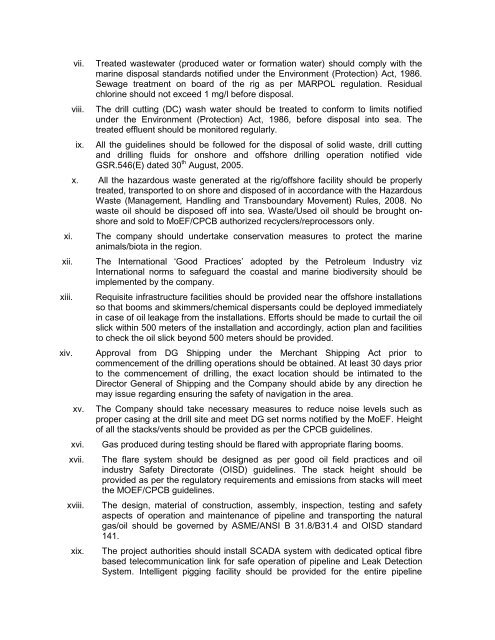MINUTES OF2ND RECONSTITUTED EXPERT APPRAISAL ...
MINUTES OF2ND RECONSTITUTED EXPERT APPRAISAL ...
MINUTES OF2ND RECONSTITUTED EXPERT APPRAISAL ...
- No tags were found...
Create successful ePaper yourself
Turn your PDF publications into a flip-book with our unique Google optimized e-Paper software.
xi.xii.xiii.xiv.vii.viii.ix.Treated wastewater (produced water or formation water) should comply with themarine disposal standards notified under the Environment (Protection) Act, 1986.Sewage treatment on board of the rig as per MARPOL regulation. Residualchlorine should not exceed 1 mg/l before disposal.The drill cutting (DC) wash water should be treated to conform to limits notifiedunder the Environment (Protection) Act, 1986, before disposal into sea. Thetreated effluent should be monitored regularly.All the guidelines should be followed for the disposal of solid waste, drill cuttingand drilling fluids for onshore and offshore drilling operation notified videGSR.546(E) dated 30 th August, 2005.x. All the hazardous waste generated at the rig/offshore facility should be properlytreated, transported to on shore and disposed of in accordance with the HazardousWaste (Management, Handling and Transboundary Movement) Rules, 2008. Nowaste oil should be disposed off into sea. Waste/Used oil should be brought onshoreand sold to MoEF/CPCB authorized recyclers/reprocessors only.xv.xvi.xvii.xviii.xix.The company should undertake conservation measures to protect the marineanimals/biota in the region.The International ‘Good Practices’ adopted by the Petroleum Industry vizInternational norms to safeguard the coastal and marine biodiversity should beimplemented by the company.Requisite infrastructure facilities should be provided near the offshore installationsso that booms and skimmers/chemical dispersants could be deployed immediatelyin case of oil leakage from the installations. Efforts should be made to curtail the oilslick within 500 meters of the installation and accordingly, action plan and facilitiesto check the oil slick beyond 500 meters should be provided.Approval from DG Shipping under the Merchant Shipping Act prior tocommencement of the drilling operations should be obtained. At least 30 days priorto the commencement of drilling, the exact location should be intimated to theDirector General of Shipping and the Company should abide by any direction hemay issue regarding ensuring the safety of navigation in the area.The Company should take necessary measures to reduce noise levels such asproper casing at the drill site and meet DG set norms notified by the MoEF. Heightof all the stacks/vents should be provided as per the CPCB guidelines.Gas produced during testing should be flared with appropriate flaring booms.The flare system should be designed as per good oil field practices and oilindustry Safety Directorate (OISD) guidelines. The stack height should beprovided as per the regulatory requirements and emissions from stacks will meetthe MOEF/CPCB guidelines.The design, material of construction, assembly, inspection, testing and safetyaspects of operation and maintenance of pipeline and transporting the naturalgas/oil should be governed by ASME/ANSI B 31.8/B31.4 and OISD standard141.The project authorities should install SCADA system with dedicated optical fibrebased telecommunication link for safe operation of pipeline and Leak DetectionSystem. Intelligent pigging facility should be provided for the entire pipeline
















